7 Evidence of Evolution
At the end of this chapter, you will be able to:
- Explain the pieces of evidence to support evolution
- Distinguish between the different types of fossils
- Compare and contrast homologous structures to analogous structures
- Describe the role that hox genes play in the development of embryos
Introduction
Evolution is the change in the allelic frequency of a trait over time. Sometimes the changes are small resulting in the change of the variation of a trait in the same species – we would call this microevolution. Other times, so much DNA changes that we say a new species has formed, that is macroevolution has occurred. Regardless, there are different types of evidence that scientists use to support evolution. So much evidence has been collected from different disciplines, such as geology, embryology, genetics, and cell biology, that we refer to evolution as a theory. It has been supported by so many disciplines and has stood the test of time.
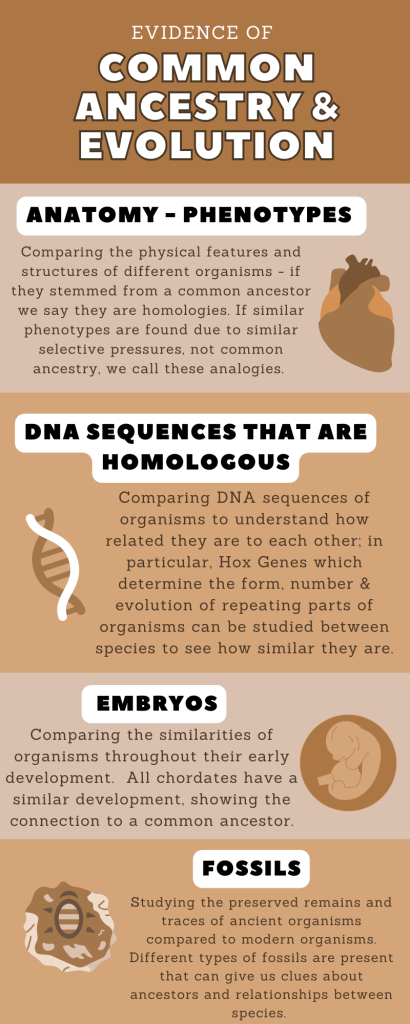
Physical Evidence
Fossils are the preserved remains or traces of organisms that lived in the remote past (over 10,000 years ago). Many different types of fossils occur in various steps of completeness, collectively forming the fossil record, which provides a wealth of information about evolution (Fig 1).
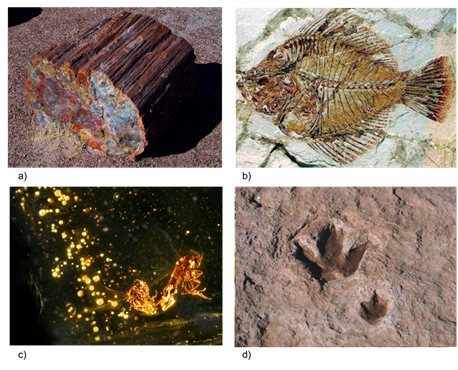
Figure 1: Examples of fossilized remains a) petrified wood from Petrified Forest National Park, Arizona; b) a fossilized flatfish; c) two 125-million-year-old dung midges, perfectly preserved in amber, are the oldest preserved mating pair in the animal kingdom; and d) fossilized dinosaur footprints.
Some fossils are mineralized remains that result from a process in which living tissues are replaced by minerals such as quartz, calcite, and silica. In some cases, a near-perfect representative of an organism is captured in stone—this is called petrifaction. Petrified wood looks a lot like a tree trunk or branch, but if you touch it or kick it, you’ll find out quickly that it’s made of stone. We have learned a lot from petrified wood; for example, the discovery of fossilized tree trunks and leaves in Antarctica suggests the icy landscape was once covered by lush green forests.
The remains of some organisms are only evident as casts or molds. Molds are impressions left by organisms, whereas casts represent molds that have been filled in by mineralization. In particular, sedimentary rock, which is formed by years of sand accumulating in layers on ancient sea floors, is an excellent source of fossil remains of aquatic organisms. For example, recent discoveries of fish casts have clarified some details about flatfish evolution. Flatfish, such as flounders, have eyes on one side of their heads, posing the question: how did such a body plan evolve? In the past several years, many examples of ancient fish with “transitional” eye arrangements have been discovered; specifically, these fish had eyes that were arranged intermediate to those of flounders and typical bony fish.
Some organisms persist long after death as unaltered remains. Unaltered remains have changed little since they died, and include hard, decay-resistant tissues such as teeth or shells. Soft tissues can also persist for thousands of years if they have been protected from heat or oxygen (both of which cause decay). Unaltered remains are typically found in ice, amber, or tar deposits. In 2012, an international team of scientists discovered two new species of small insects perfectly preserved in amber (fossilized tree resin) from over 100 million years ago. The discovery of these insects, called thrips, is exciting by itself, but the thrips also carried tiny pollen grains on their wings and abdomens. This is the oldest known evidence of pollination, whereby an animal carries a plant’s sperm (as pollen grains) to eggs. This is also the first example of pollination from the era of the dinosaurs.
Trace remains are fossilized evidence of living organisms, but not the actual organisms themselves. Examples of trace remains include footprints preserved in rock, mineralized feces (or coprolites), and the molds of once-inhabited burrows. The recent discovery of reptile footprints, in a location that would have been hundreds of miles from the sea, suggests that reptiles have been able to move into continental interiors for at least 318 million years. This discovery pushed back earlier estimates for the movement of reptiles away from the sea by several million years.
Related organisms have similar bodily structures or anatomy; for example, the skeletons of humans, rats, and bats are similar, despite numerous obvious differences. There is a bone-by-bone similarity in the bodies of these three animals. Anatomical similarities are particularly evident in a comparison of the forelimbs of the pterodactyl, bat, hawk, whale, and human (Fig 2). These animals live in different types of environments and use their limbs for different functions–flying, swimming, or grasping and throwing. Despite these different functions, all of these animals possess limbs with certain shared characteristics: a five-digit structure, a single large bone (humerus), two bones in the forearm (ulna and radius), and several wrist bones. These bones are homologous to each other, that is, they were inherited from a common ancestor.

Figure 2: Homologies in vertebrate forelimbs.
All four-limbed animals (or tetrapods)–amphibians, reptiles, birds, and mammals–have similar limbs. Anatomical similarities, such as those that characterize tetrapod limbs, are used as evidence for common ancestry. In other words, these similarities suggest that pterodactyls, bats, hawks, whales, and humans all share a common ancestor somewhere in their distant past. Learning about shared ancestry provides an important clue to understanding an organism’s evolution.
Homologous structures are anatomical features that different organisms share as a result of a common ancestor. The tetrapod limbs discussed above are homologous structures or homologies. Because they evolved in an ancestor and are currently shared by different organisms, homologies are often called shared derived traits. Cactus spines, the leaves of a maple tree, and the cup-like “pitcher” of a pitcher plant are all modified from a common structure in an ancestor shared by all leaf-bearing land plants. While these leaves look different and have evolved to serve different purposes, they are homologous structures and tell important stories about each plant’s history (Fig 3).
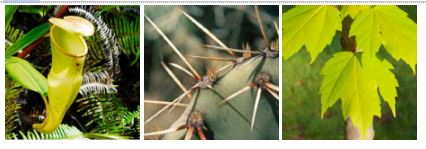
Figure 3: Leaves as homologous structures. Cactus spines, the leaves of a maple tree, and the cup-like “pitcher” of a pitcher plant are all modified from a common structure in an ancestor shared by all leaf-bearing land plants.
Analogous structures are anatomical features that different types of organisms share, but not as a result of a shared ancestor. Instead, analogous structures, or analogies, are similar because the organisms have changed in response to similar environments. When distantly related organisms share features as a result of similar environmental pressures (and not because of common ancestry), we say that they have undergone convergent evolution. For example, arctic mammals such as foxes and snowshoe hares grow white fur during the winter months. White fur allows these organisms to blend into the ice and snow that characterizes their polar home and presumably protects them from predation. Foxes and snowshoe hares, however, do not share a common ancestor with white fur. Of course, they ultimately share a common ancestor, as do all mammals, but the fox lineage is full of non-white animals, as is the group to which hares belong. The winter white of arctic foxes and snowshoe hares is thus an analogous structure, due to convergent evolution in a white, wintry landscape.
Vestigial structures are anatomical features that are either no longer in use or their use has been greatly reduced or altered. Vestigial structures, or vestigia, provide clues to an organism’s history by suggesting what features were useful in the past, and by linking an organism to other, related organisms. For example, many mammals exhibit piloerection, whereby muscles constrict around the hair follicles and the animal’s hair stands on end. If you’ve ever surprised or otherwise threatened a dog or cat, you’ve probably seen the results of piloerection. Humans are mammals too, but we’ve been reduced to a scant covering of body hair. When we are scared, we also constrict the muscles around our hair follicles, but this just gives us goosebumps (Fig 4). Goosebumps aren’t very scary, but as vestigia they link us to our mammalian relatives and tell us something about our evolutionary history.
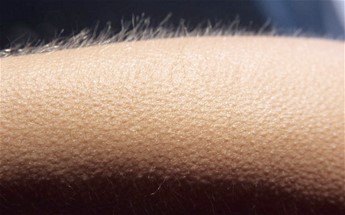
Figure 4: The Vestigial piloerection of humans leads to goosebumps
Biogeographical Evidence
Biogeography, the study of the distribution of living organisms, addresses several evolutionary questions: How many types of organisms exist? Why are some types of organisms (e.g. insects) more abundant than others (e.g. mammals)? Why do certain organisms live in some places and not others? Why do islands have such distinct biodiversity compared to the larger continents? Why aren’t there any polar bears in Antarctica? Why aren’t there any giraffes in Hawaii? And so on….
Likewise, an understanding of evolution helps us appreciate the otherwise perplexing global distribution of marsupial mammals (Fig 5). Marsupials are mammals in which females transport their young in distinctive pouches throughout their early infancy. In contrast, placental mammals have placental gestation and young that are born at a more developed stage. Marsupial mammals, such as kangaroos, opossums, wombats, and wallabies, occur in North and South America, Australia, and New Guinea, whereas the more numerous placental mammals dominate the rest of the world. How can we explain these odd distribution patterns?
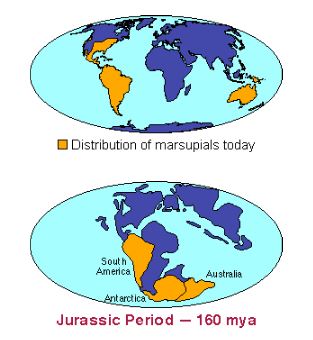
Figure 5: Distribution of marsupials today versus Jurassic period
Knowledge of Earth’s history is key to biogeography and evolutionary understanding. Indeed, a consideration of continental drift—the movement of the continents, over geologic time, as a result of the movement of plates in Earth’s crust—is necessary to understand marsupial biogeography (Fig 6). We also know, from fossil evidence, that marsupials originated over 150 million years ago in China, at a time when the Asian and North American landmasses were joined. Marsupials dispersed to South America, and from there to Antarctica and Australia, both of which were attached to South America. When Australia, Antarctica, and South America drifted apart, each landmass carried a population of marsupial mammals. Over time, Australia’s marsupials evolved into the bandicoots, kangaroos, koalas, and other marsupials that inhabit the continent today. When Australia moved closer to Asia, about 15 million years ago, placental mammals such as rats and bats colonized the landmass.
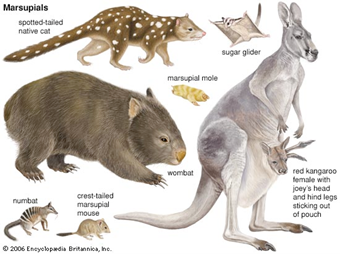
Figure 7: Marsupial mammals
Embryonic Development
Scientists can study how organisms develop and change after an egg is fertilized. In vertebrates, you will see a fertilized egg undergoing cleavage or embryonic cell division resulting in many cells. This solid ball of cells called a morula will continue to undergo embryonic development and change into a hollow ball of cells called blastula. Then cells migrate and change to give rise to another stage called gastrula. Underneath a microscope, you would likely not know if you were viewing a mouse, a sea urchin, or a chicken. These organisms look very similar at these early stages. This indicates these organisms’ common ancestor (recall the term homologous).
Many species, however, that exhibit similar structures during embryonic development eventually differentiate in that these structures serve different functions in adults. These homologous structures indicate a common ancestry. For example, vertebrate embryos, including humans, fish, birds, and reptiles, all have pharyngeal pouches at certain developmental stages, which in fish develop into gills, while in humans, they form parts of the ear and throat.
While the concept that embryonic development stages (ontogeny) directly repeat evolutionary history (phylogeny) is outdated in its original form, the idea still holds in a more nuanced sense. Early embryonic stages show similarities across species that reflect shared evolutionary paths, even if later development diverges significantly.
Additionally, embryos often exhibit vestigial structures that are not present in the adult form but indicate evolutionary ancestry. Recall that vestigial structures are no longer useful or functional but are present based on ancestor carry-over. For instance, human embryos have a tail and a lanugo coat of fine hair, reflecting our evolutionary past.
In general, studying the differences and similarities in embryonic development stages across species can help reconstruct evolutionary relationships. Species that share more similar developmental pathways are often more closely related.
Genetic Evidence
DNA can provide a lot of information to help us study relationships among organisms. We can look at genes from 2 species to determine if they are similar or different to help us understand how closely or distantly related they are to one another. Homeotic genes are sections of DNA that play a key role in the developmental process as embryos undergo all sorts of changes. Homeotic genes act as on-and-off switches to help with the positioning of cells within the organism’s body plan.
One group of homeotic genes that turn out to be very helpful for understanding evolution is hox genes. Hox genes determine the form, number, and evolution of repeating parts, such as the number and type of vertebrae in animals. The role of hox genes is to specify positional identity in the embryo which will lead to corresponding structures in the adult. For example, at least eight different Hox genes are critical for the development of different body segments in fruit flies (Drosophila; Fig 8). Hox genes also affect the orientation of segments such that the anterior-to-posterior orientation is maintained. Scientists have learned that hox genes are part of a “toolbox” of genes that can be shuffled and rearranged to create the diversity of species we find on the planet.
When studying animal species, we find animal species with more simple body structures do not have as many hox genes as those species with more complex bodies. For example, a mammal such as a mouse will have many more hox genes than a flatworm. Humans have over 200 homeotic genes, and out of that, 39 are hox genes.
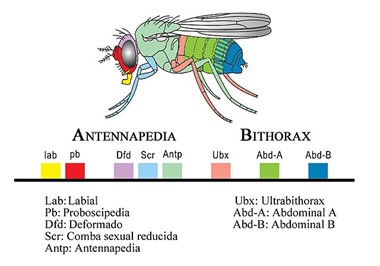
Figure 8: The hox genes arranged on a chromosome found in the fruit fly. Each box of color represents a gene, a section of DNA, that helps determine the body part on the fly highlighted in the same color. For example, the yellow hox gene “lab” will help to dictate the labial mouth part of the adult fly. Antonio Quesada Díaz, Public domain, via Wikimedia Commons
Plant species also have homeotic genes that can determine reproductive structures, such as stamens, carpel, and petals of flowering plants (Fig 9). Because flowers are the reproductive organs of angiosperms, a small change to the homeotic genes underlying the development of these structures can have a large impact on the phenotype and reproductive success of an individual and help drive evolution.

Figure 9: Parts of a Flower. The pistil comprises the female part and the stamen, the male part. LadyofHats, Public domain, via Wikimedia Commons
When looking more closely at homeotic genes, scientists discovered a 180-base-pair sequence to be identical in a wide array of animal species. This 180 base-pair sequence is called the homeobox and is highly conserved across evolutionary time (and it was first discovered in Drosophila). This suggests that hox genes arose very early in evolutionary time. The shared homeobox sequence suggests an ancestral gene was present and duplicated multiple times over evolutionary time to give rise to what we find today. Scientists get very excited about the homeobox because mutations in this gene can cause dramatic developmental changes in body parts and can lead to speciation.
Hox genes, as mentioned above, are conserved across species. We find some of the human hox genes are homologous to those in the fruit fly. In experiments with mice, the Hox10 genes turn the “rib” genes off which are normally active in the lower back, but not needed. When scientists experimentally manipulated these genes they can cause ribs to grow in the vertebrae of the lower back. As such, we can see hox genes dictating arms versus legs as well as differentiating specific fingers, like a thumb or a pinky. The variation on the theme of the hox genes will give an organism a variety of traits and can lead to speciation.
Watch this animation on how these master genes control basic body plans: Fruit fly gene expression, development :: DNA from the Beginning (dnaftb.org)
Summary
Macroevolution refers to large-scale evolutionary changes that occur over long time periods, leading to the emergence of new species and broader taxonomic groups. Several lines of evidence support macroevolution, including fossils, embryonic development, Hox genes, homologous structures, and biogeography.
- Fossils: The fossil record provides a chronological account of life on Earth, documenting the appearance, diversification, and extinction of species over millions of years. Transitional fossils, such as those of Archaeopteryx (a link between dinosaurs and birds) and Tiktaalik (a bridge between fish and tetrapods), illustrate intermediary forms that reflect gradual evolutionary changes. Fossils reveal patterns of descent with modification, supporting the theory of common ancestry.
- Biogeography: The geographic distribution of species provides evidence for macroevolution. Biogeography studies how species are distributed across the Earth and how they came to be in their current locations. The presence of similar species on different continents can often be explained by plate tectonics and the historical connections between land masses. For example, the distribution of marsupials in Australia and South America suggests that these continents were once connected, allowing for the spread and diversification of these animals before continental drift separated them.
- Embryonic Development: Embryology shows that many species undergo similar developmental stages, suggesting a shared evolutionary history. For example, vertebrate embryos exhibit pharyngeal pouches and tails, features inherited from a common ancestor. These developmental similarities, despite differences in adult forms, provide evidence for evolutionary relationships and common ancestry.
- Hox Genes: Hox genes are crucial regulators of body plan development and are remarkably conserved across diverse species. These genes determine the identity and arrangement of body segments, influencing the development of structures such as limbs and organs. The conservation of Hox genes across the animal kingdom indicates that these genes originated in a common ancestor and have been modified to produce the diversity of life forms seen today.
- Homologous Structures: Homologous structures are anatomical features in different species that have a similar origin but may serve different functions. For instance, the forelimbs of mammals, birds, and reptiles share a common skeletal structure despite being adapted for various activities like grasping, flying, or swimming. These similarities reflect evolutionary changes from a common ancestor, highlighting the concept of descent with modification.
Questions
Glossary
References
Cotner S. and D Wassenberg. The Evolution and Biology of Sex.
Genetic Science Learning Center. University of Utah. Homeotic Genes and Body Patterns. Found at https://learn.genetics.utah.edu/content/basics/hoxgenes/
Kosal, E. 2023. Genetics Evidence section. NC State University

